Management Essay: Coca-Cola Strategy
VerifiedAdded on 2019/11/26
|12
|2801
|381
Essay
AI Summary
This essay examines Coca-Cola's competitive strategy through the lens of Porter's four generic strategies: cost leadership, differentiation, cost focus, and differentiation focus. It analyzes Coca-Cola's existing cost leadership position, arguing that focusing on product differentiation—introducing new product lines and innovating existing ones—is the most effective path to future competitive advantage. The essay emphasizes the importance of maintaining product quality and balancing product differentiation with cost-conscious marketing and promotional strategies. The conclusion recommends a strategic shift towards product differentiation while maintaining a narrow focus on cost control to maximize profitability and market share.
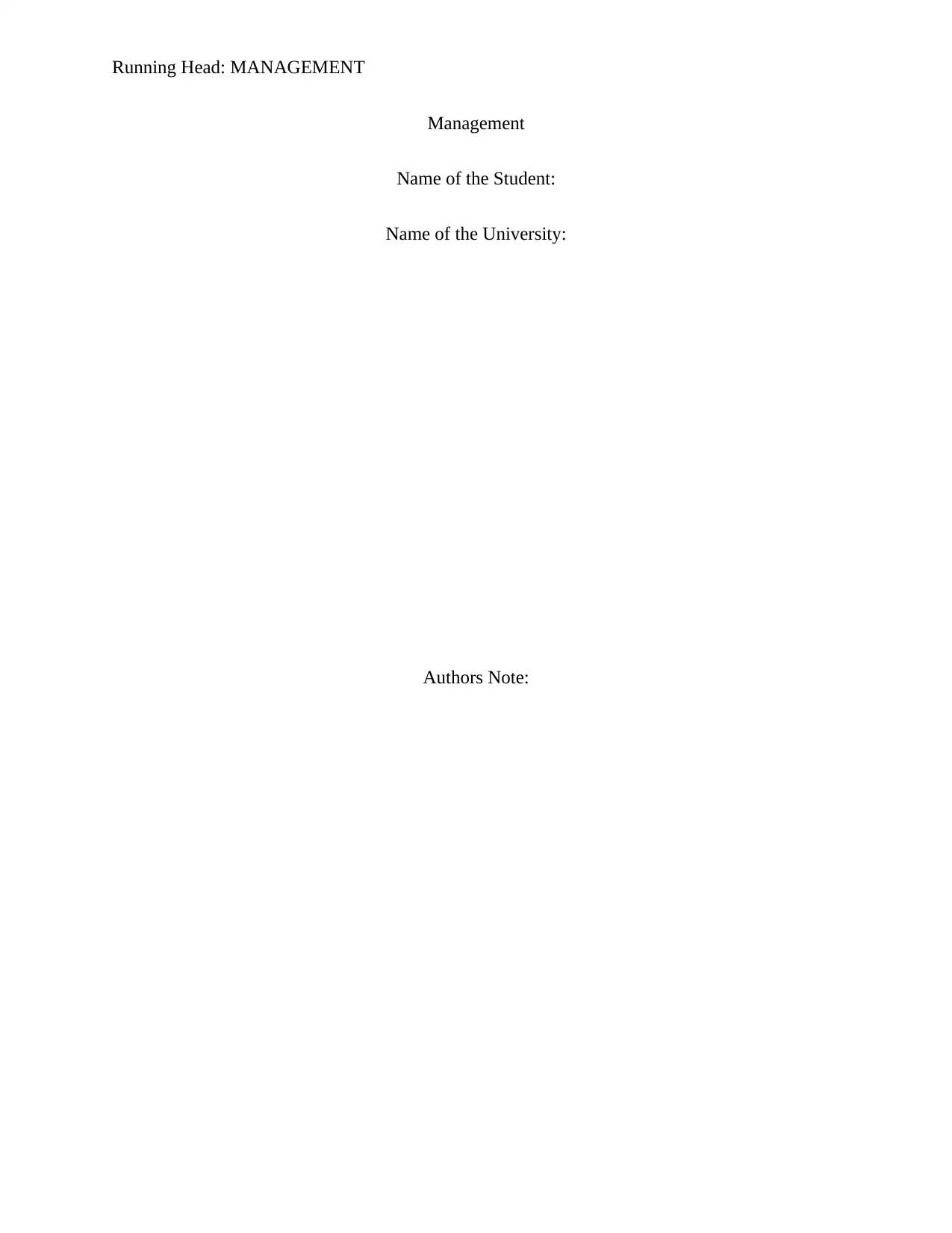
Running Head: MANAGEMENT
Management
Name of the Student:
Name of the University:
Authors Note:
Management
Name of the Student:
Name of the University:
Authors Note:
Paraphrase This Document
Need a fresh take? Get an instant paraphrase of this document with our AI Paraphraser
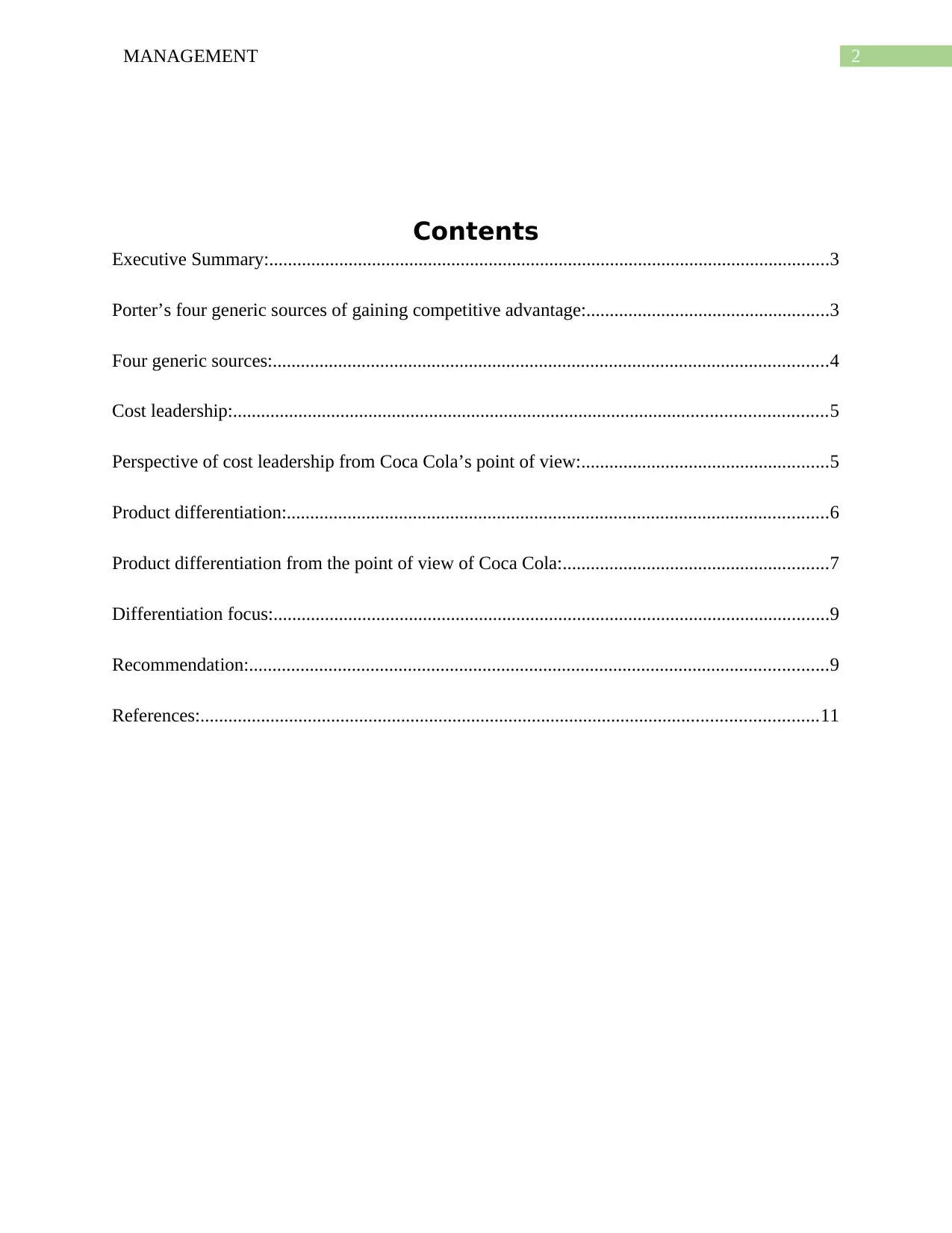
2MANAGEMENT
Contents
Executive Summary:........................................................................................................................3
Porter’s four generic sources of gaining competitive advantage:....................................................3
Four generic sources:.......................................................................................................................4
Cost leadership:...............................................................................................................................5
Perspective of cost leadership from Coca Cola’s point of view:.....................................................5
Product differentiation:....................................................................................................................6
Product differentiation from the point of view of Coca Cola:.........................................................7
Differentiation focus:.......................................................................................................................9
Recommendation:............................................................................................................................9
References:....................................................................................................................................11
Contents
Executive Summary:........................................................................................................................3
Porter’s four generic sources of gaining competitive advantage:....................................................3
Four generic sources:.......................................................................................................................4
Cost leadership:...............................................................................................................................5
Perspective of cost leadership from Coca Cola’s point of view:.....................................................5
Product differentiation:....................................................................................................................6
Product differentiation from the point of view of Coca Cola:.........................................................7
Differentiation focus:.......................................................................................................................9
Recommendation:............................................................................................................................9
References:....................................................................................................................................11
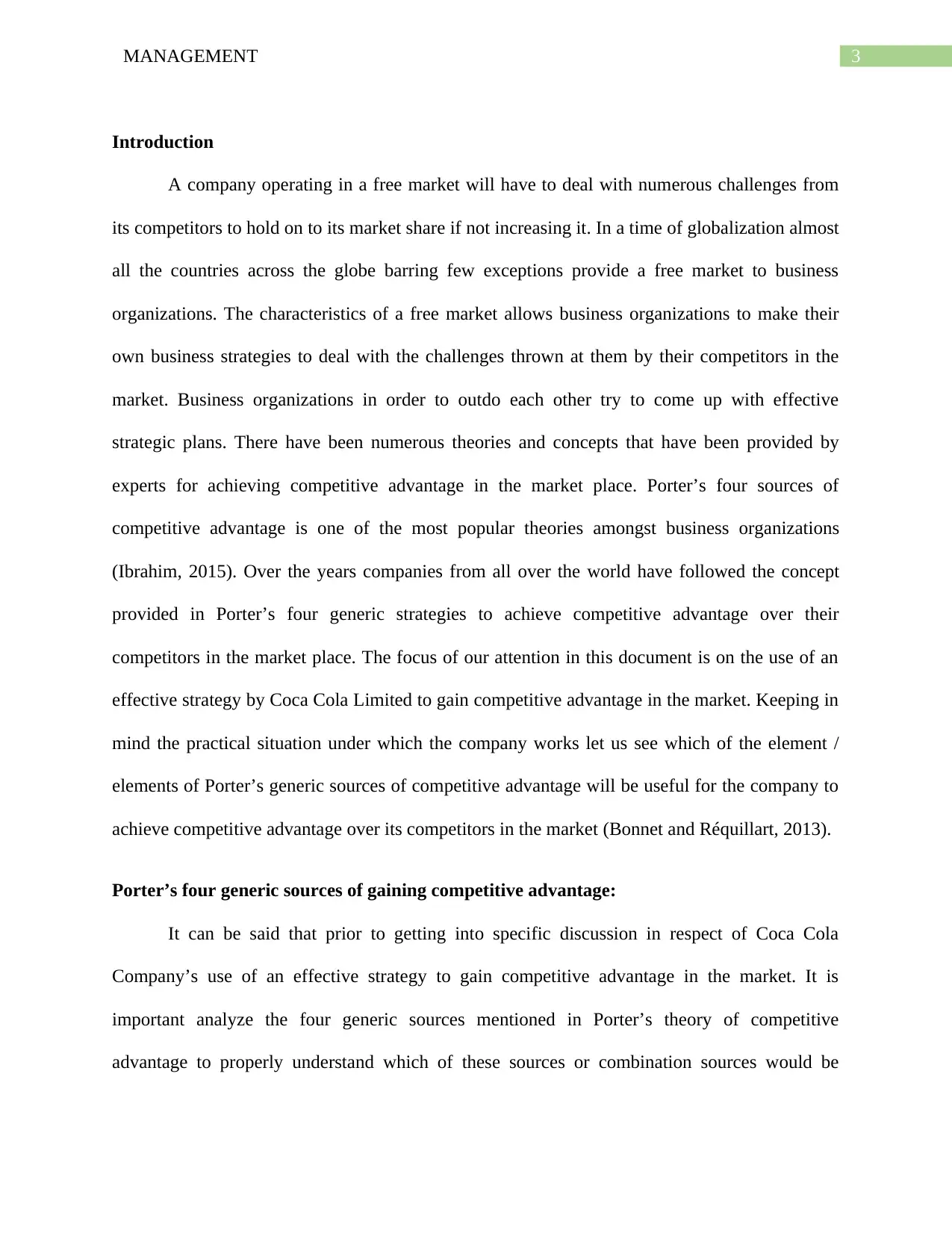
3MANAGEMENT
Introduction
A company operating in a free market will have to deal with numerous challenges from
its competitors to hold on to its market share if not increasing it. In a time of globalization almost
all the countries across the globe barring few exceptions provide a free market to business
organizations. The characteristics of a free market allows business organizations to make their
own business strategies to deal with the challenges thrown at them by their competitors in the
market. Business organizations in order to outdo each other try to come up with effective
strategic plans. There have been numerous theories and concepts that have been provided by
experts for achieving competitive advantage in the market place. Porter’s four sources of
competitive advantage is one of the most popular theories amongst business organizations
(Ibrahim, 2015). Over the years companies from all over the world have followed the concept
provided in Porter’s four generic strategies to achieve competitive advantage over their
competitors in the market place. The focus of our attention in this document is on the use of an
effective strategy by Coca Cola Limited to gain competitive advantage in the market. Keeping in
mind the practical situation under which the company works let us see which of the element /
elements of Porter’s generic sources of competitive advantage will be useful for the company to
achieve competitive advantage over its competitors in the market (Bonnet and Réquillart, 2013).
Porter’s four generic sources of gaining competitive advantage:
It can be said that prior to getting into specific discussion in respect of Coca Cola
Company’s use of an effective strategy to gain competitive advantage in the market. It is
important analyze the four generic sources mentioned in Porter’s theory of competitive
advantage to properly understand which of these sources or combination sources would be
Introduction
A company operating in a free market will have to deal with numerous challenges from
its competitors to hold on to its market share if not increasing it. In a time of globalization almost
all the countries across the globe barring few exceptions provide a free market to business
organizations. The characteristics of a free market allows business organizations to make their
own business strategies to deal with the challenges thrown at them by their competitors in the
market. Business organizations in order to outdo each other try to come up with effective
strategic plans. There have been numerous theories and concepts that have been provided by
experts for achieving competitive advantage in the market place. Porter’s four sources of
competitive advantage is one of the most popular theories amongst business organizations
(Ibrahim, 2015). Over the years companies from all over the world have followed the concept
provided in Porter’s four generic strategies to achieve competitive advantage over their
competitors in the market place. The focus of our attention in this document is on the use of an
effective strategy by Coca Cola Limited to gain competitive advantage in the market. Keeping in
mind the practical situation under which the company works let us see which of the element /
elements of Porter’s generic sources of competitive advantage will be useful for the company to
achieve competitive advantage over its competitors in the market (Bonnet and Réquillart, 2013).
Porter’s four generic sources of gaining competitive advantage:
It can be said that prior to getting into specific discussion in respect of Coca Cola
Company’s use of an effective strategy to gain competitive advantage in the market. It is
important analyze the four generic sources mentioned in Porter’s theory of competitive
advantage to properly understand which of these sources or combination sources would be
⊘ This is a preview!⊘
Do you want full access?
Subscribe today to unlock all pages.

Trusted by 1+ million students worldwide
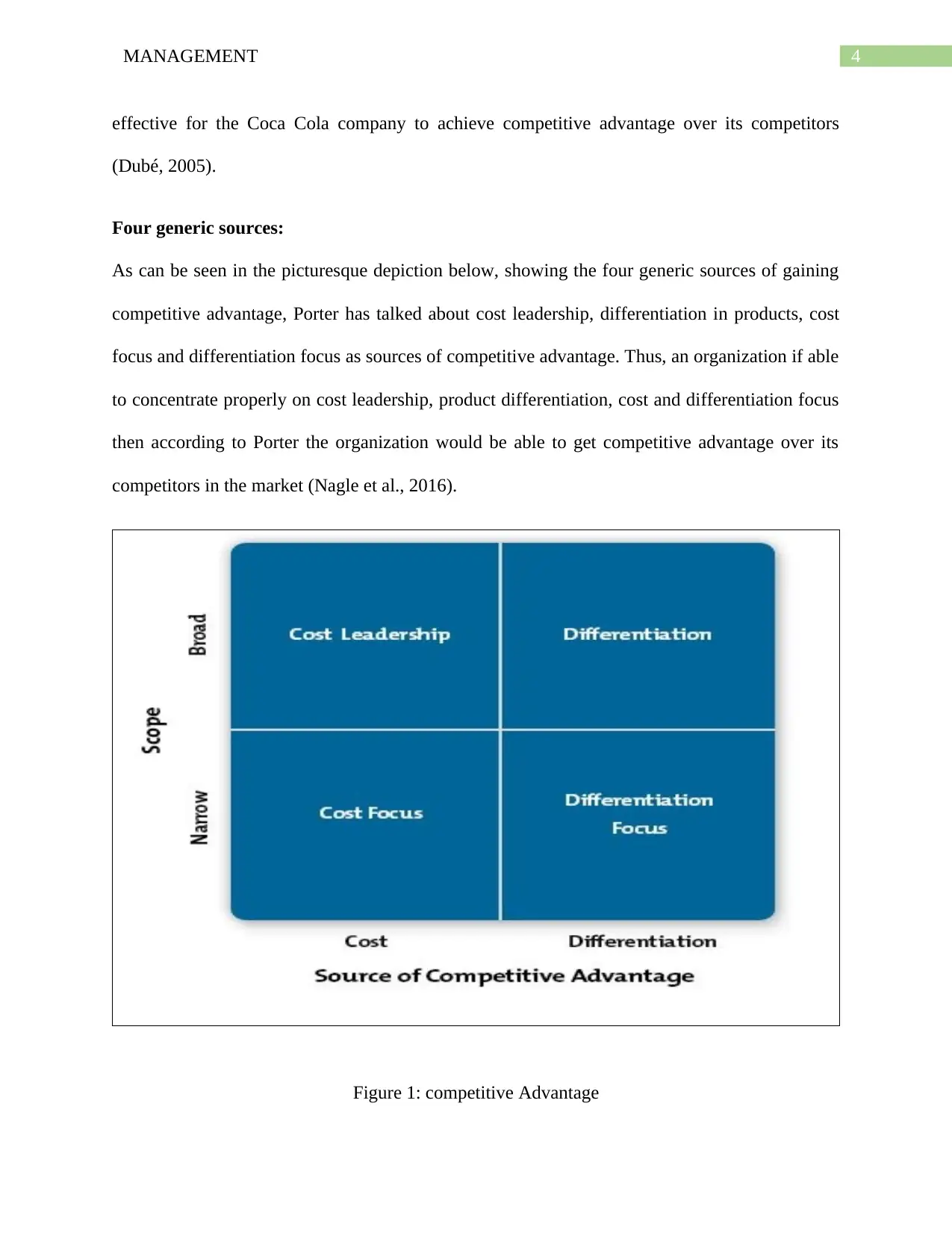
4MANAGEMENT
effective for the Coca Cola company to achieve competitive advantage over its competitors
(Dubé, 2005).
Four generic sources:
As can be seen in the picturesque depiction below, showing the four generic sources of gaining
competitive advantage, Porter has talked about cost leadership, differentiation in products, cost
focus and differentiation focus as sources of competitive advantage. Thus, an organization if able
to concentrate properly on cost leadership, product differentiation, cost and differentiation focus
then according to Porter the organization would be able to get competitive advantage over its
competitors in the market (Nagle et al., 2016).
Figure 1: competitive Advantage
effective for the Coca Cola company to achieve competitive advantage over its competitors
(Dubé, 2005).
Four generic sources:
As can be seen in the picturesque depiction below, showing the four generic sources of gaining
competitive advantage, Porter has talked about cost leadership, differentiation in products, cost
focus and differentiation focus as sources of competitive advantage. Thus, an organization if able
to concentrate properly on cost leadership, product differentiation, cost and differentiation focus
then according to Porter the organization would be able to get competitive advantage over its
competitors in the market (Nagle et al., 2016).
Figure 1: competitive Advantage
Paraphrase This Document
Need a fresh take? Get an instant paraphrase of this document with our AI Paraphraser
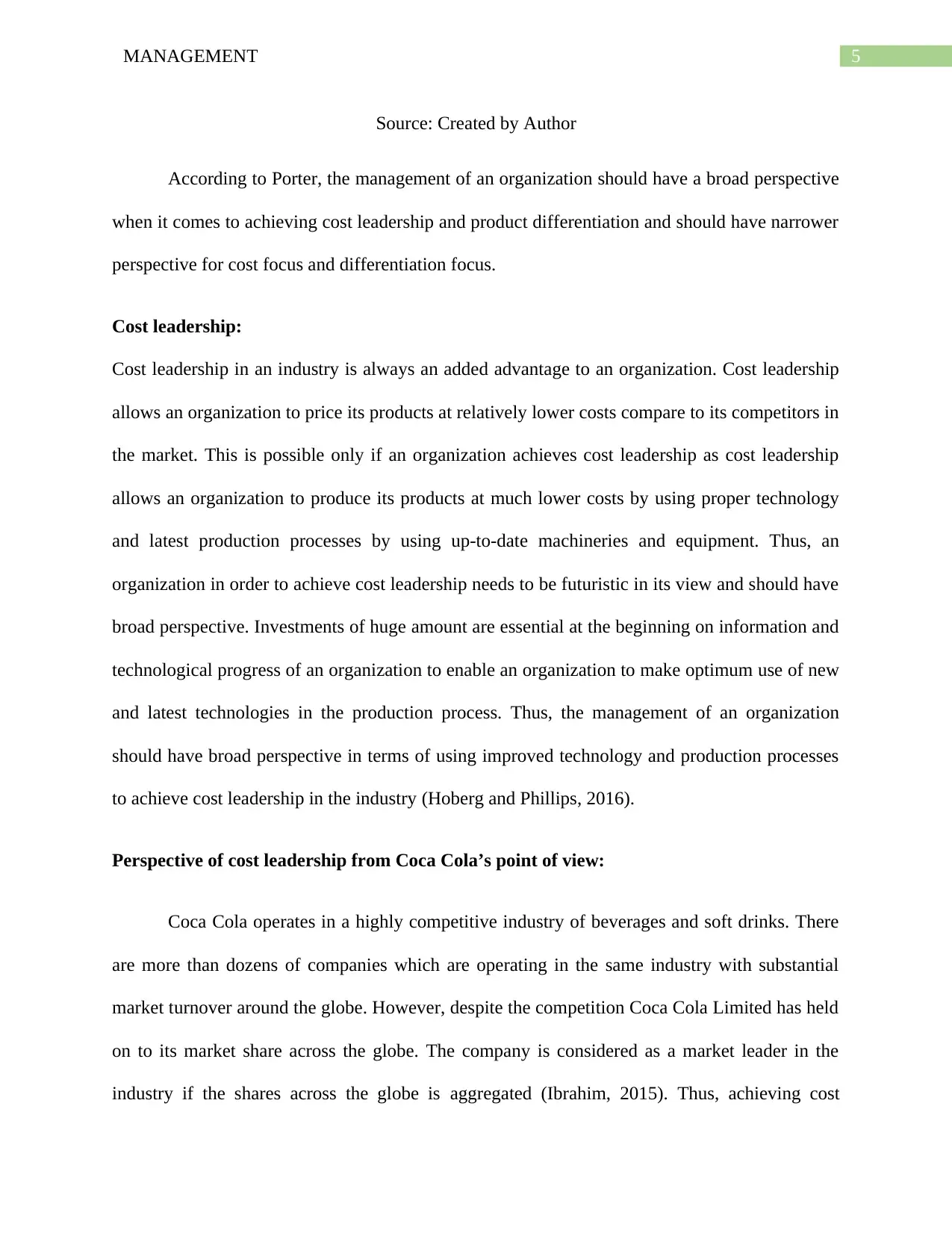
5MANAGEMENT
Source: Created by Author
According to Porter, the management of an organization should have a broad perspective
when it comes to achieving cost leadership and product differentiation and should have narrower
perspective for cost focus and differentiation focus.
Cost leadership:
Cost leadership in an industry is always an added advantage to an organization. Cost leadership
allows an organization to price its products at relatively lower costs compare to its competitors in
the market. This is possible only if an organization achieves cost leadership as cost leadership
allows an organization to produce its products at much lower costs by using proper technology
and latest production processes by using up-to-date machineries and equipment. Thus, an
organization in order to achieve cost leadership needs to be futuristic in its view and should have
broad perspective. Investments of huge amount are essential at the beginning on information and
technological progress of an organization to enable an organization to make optimum use of new
and latest technologies in the production process. Thus, the management of an organization
should have broad perspective in terms of using improved technology and production processes
to achieve cost leadership in the industry (Hoberg and Phillips, 2016).
Perspective of cost leadership from Coca Cola’s point of view:
Coca Cola operates in a highly competitive industry of beverages and soft drinks. There
are more than dozens of companies which are operating in the same industry with substantial
market turnover around the globe. However, despite the competition Coca Cola Limited has held
on to its market share across the globe. The company is considered as a market leader in the
industry if the shares across the globe is aggregated (Ibrahim, 2015). Thus, achieving cost
Source: Created by Author
According to Porter, the management of an organization should have a broad perspective
when it comes to achieving cost leadership and product differentiation and should have narrower
perspective for cost focus and differentiation focus.
Cost leadership:
Cost leadership in an industry is always an added advantage to an organization. Cost leadership
allows an organization to price its products at relatively lower costs compare to its competitors in
the market. This is possible only if an organization achieves cost leadership as cost leadership
allows an organization to produce its products at much lower costs by using proper technology
and latest production processes by using up-to-date machineries and equipment. Thus, an
organization in order to achieve cost leadership needs to be futuristic in its view and should have
broad perspective. Investments of huge amount are essential at the beginning on information and
technological progress of an organization to enable an organization to make optimum use of new
and latest technologies in the production process. Thus, the management of an organization
should have broad perspective in terms of using improved technology and production processes
to achieve cost leadership in the industry (Hoberg and Phillips, 2016).
Perspective of cost leadership from Coca Cola’s point of view:
Coca Cola operates in a highly competitive industry of beverages and soft drinks. There
are more than dozens of companies which are operating in the same industry with substantial
market turnover around the globe. However, despite the competition Coca Cola Limited has held
on to its market share across the globe. The company is considered as a market leader in the
industry if the shares across the globe is aggregated (Ibrahim, 2015). Thus, achieving cost
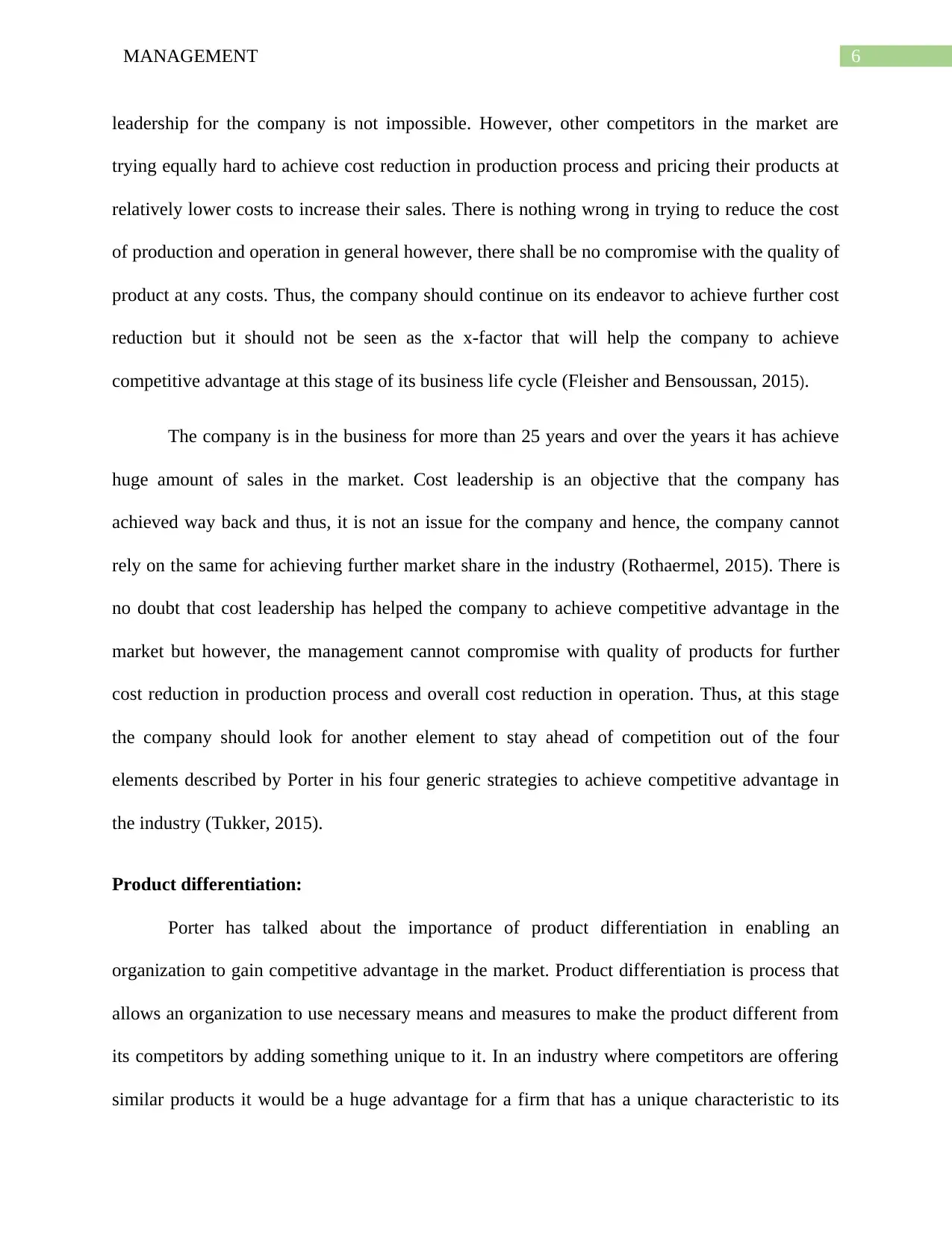
6MANAGEMENT
leadership for the company is not impossible. However, other competitors in the market are
trying equally hard to achieve cost reduction in production process and pricing their products at
relatively lower costs to increase their sales. There is nothing wrong in trying to reduce the cost
of production and operation in general however, there shall be no compromise with the quality of
product at any costs. Thus, the company should continue on its endeavor to achieve further cost
reduction but it should not be seen as the x-factor that will help the company to achieve
competitive advantage at this stage of its business life cycle (Fleisher and Bensoussan, 2015).
The company is in the business for more than 25 years and over the years it has achieve
huge amount of sales in the market. Cost leadership is an objective that the company has
achieved way back and thus, it is not an issue for the company and hence, the company cannot
rely on the same for achieving further market share in the industry (Rothaermel, 2015). There is
no doubt that cost leadership has helped the company to achieve competitive advantage in the
market but however, the management cannot compromise with quality of products for further
cost reduction in production process and overall cost reduction in operation. Thus, at this stage
the company should look for another element to stay ahead of competition out of the four
elements described by Porter in his four generic strategies to achieve competitive advantage in
the industry (Tukker, 2015).
Product differentiation:
Porter has talked about the importance of product differentiation in enabling an
organization to gain competitive advantage in the market. Product differentiation is process that
allows an organization to use necessary means and measures to make the product different from
its competitors by adding something unique to it. In an industry where competitors are offering
similar products it would be a huge advantage for a firm that has a unique characteristic to its
leadership for the company is not impossible. However, other competitors in the market are
trying equally hard to achieve cost reduction in production process and pricing their products at
relatively lower costs to increase their sales. There is nothing wrong in trying to reduce the cost
of production and operation in general however, there shall be no compromise with the quality of
product at any costs. Thus, the company should continue on its endeavor to achieve further cost
reduction but it should not be seen as the x-factor that will help the company to achieve
competitive advantage at this stage of its business life cycle (Fleisher and Bensoussan, 2015).
The company is in the business for more than 25 years and over the years it has achieve
huge amount of sales in the market. Cost leadership is an objective that the company has
achieved way back and thus, it is not an issue for the company and hence, the company cannot
rely on the same for achieving further market share in the industry (Rothaermel, 2015). There is
no doubt that cost leadership has helped the company to achieve competitive advantage in the
market but however, the management cannot compromise with quality of products for further
cost reduction in production process and overall cost reduction in operation. Thus, at this stage
the company should look for another element to stay ahead of competition out of the four
elements described by Porter in his four generic strategies to achieve competitive advantage in
the industry (Tukker, 2015).
Product differentiation:
Porter has talked about the importance of product differentiation in enabling an
organization to gain competitive advantage in the market. Product differentiation is process that
allows an organization to use necessary means and measures to make the product different from
its competitors by adding something unique to it. In an industry where competitors are offering
similar products it would be a huge advantage for a firm that has a unique characteristic to its
⊘ This is a preview!⊘
Do you want full access?
Subscribe today to unlock all pages.

Trusted by 1+ million students worldwide
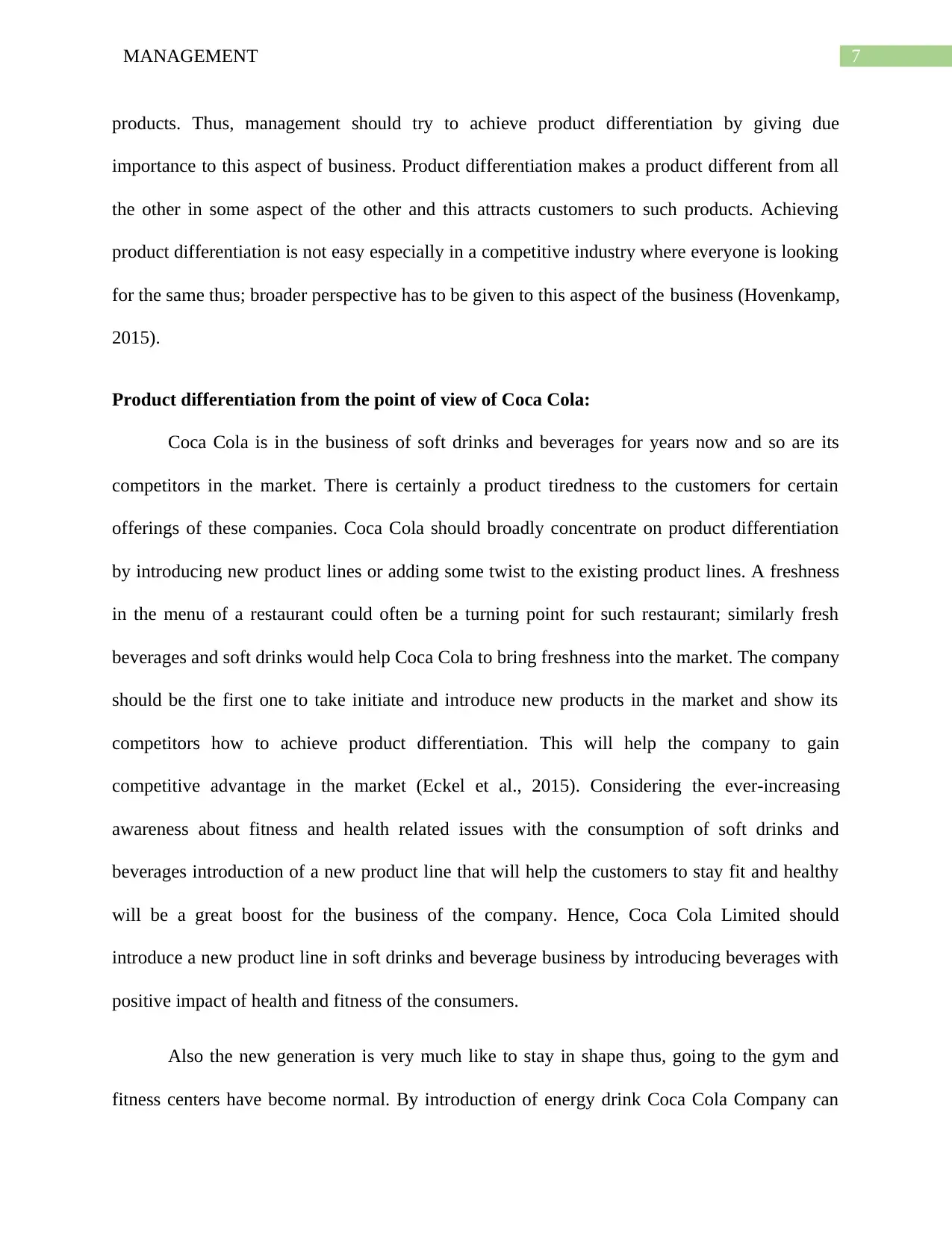
7MANAGEMENT
products. Thus, management should try to achieve product differentiation by giving due
importance to this aspect of business. Product differentiation makes a product different from all
the other in some aspect of the other and this attracts customers to such products. Achieving
product differentiation is not easy especially in a competitive industry where everyone is looking
for the same thus; broader perspective has to be given to this aspect of the business (Hovenkamp,
2015).
Product differentiation from the point of view of Coca Cola:
Coca Cola is in the business of soft drinks and beverages for years now and so are its
competitors in the market. There is certainly a product tiredness to the customers for certain
offerings of these companies. Coca Cola should broadly concentrate on product differentiation
by introducing new product lines or adding some twist to the existing product lines. A freshness
in the menu of a restaurant could often be a turning point for such restaurant; similarly fresh
beverages and soft drinks would help Coca Cola to bring freshness into the market. The company
should be the first one to take initiate and introduce new products in the market and show its
competitors how to achieve product differentiation. This will help the company to gain
competitive advantage in the market (Eckel et al., 2015). Considering the ever-increasing
awareness about fitness and health related issues with the consumption of soft drinks and
beverages introduction of a new product line that will help the customers to stay fit and healthy
will be a great boost for the business of the company. Hence, Coca Cola Limited should
introduce a new product line in soft drinks and beverage business by introducing beverages with
positive impact of health and fitness of the consumers.
Also the new generation is very much like to stay in shape thus, going to the gym and
fitness centers have become normal. By introduction of energy drink Coca Cola Company can
products. Thus, management should try to achieve product differentiation by giving due
importance to this aspect of business. Product differentiation makes a product different from all
the other in some aspect of the other and this attracts customers to such products. Achieving
product differentiation is not easy especially in a competitive industry where everyone is looking
for the same thus; broader perspective has to be given to this aspect of the business (Hovenkamp,
2015).
Product differentiation from the point of view of Coca Cola:
Coca Cola is in the business of soft drinks and beverages for years now and so are its
competitors in the market. There is certainly a product tiredness to the customers for certain
offerings of these companies. Coca Cola should broadly concentrate on product differentiation
by introducing new product lines or adding some twist to the existing product lines. A freshness
in the menu of a restaurant could often be a turning point for such restaurant; similarly fresh
beverages and soft drinks would help Coca Cola to bring freshness into the market. The company
should be the first one to take initiate and introduce new products in the market and show its
competitors how to achieve product differentiation. This will help the company to gain
competitive advantage in the market (Eckel et al., 2015). Considering the ever-increasing
awareness about fitness and health related issues with the consumption of soft drinks and
beverages introduction of a new product line that will help the customers to stay fit and healthy
will be a great boost for the business of the company. Hence, Coca Cola Limited should
introduce a new product line in soft drinks and beverage business by introducing beverages with
positive impact of health and fitness of the consumers.
Also the new generation is very much like to stay in shape thus, going to the gym and
fitness centers have become normal. By introduction of energy drink Coca Cola Company can
Paraphrase This Document
Need a fresh take? Get an instant paraphrase of this document with our AI Paraphraser
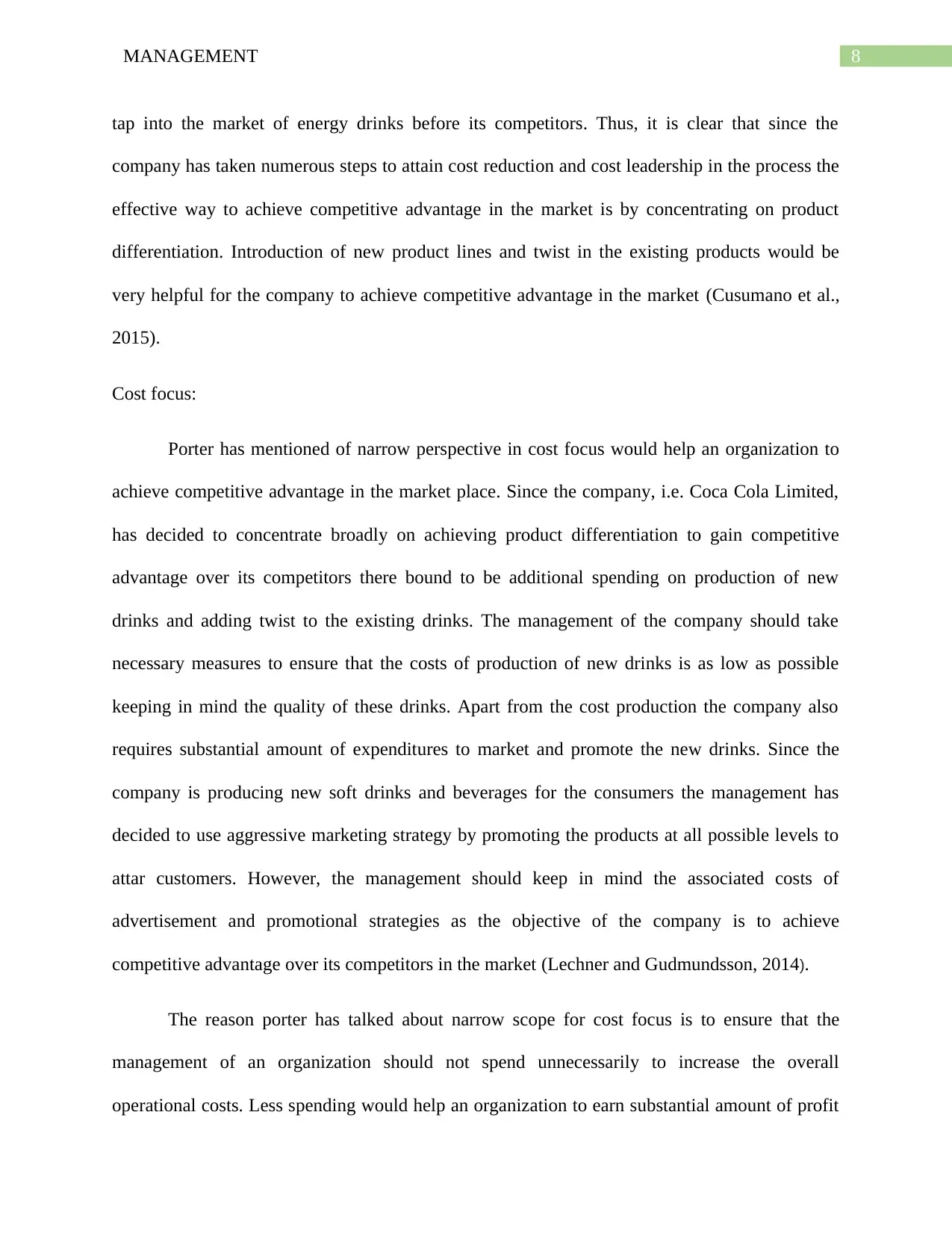
8MANAGEMENT
tap into the market of energy drinks before its competitors. Thus, it is clear that since the
company has taken numerous steps to attain cost reduction and cost leadership in the process the
effective way to achieve competitive advantage in the market is by concentrating on product
differentiation. Introduction of new product lines and twist in the existing products would be
very helpful for the company to achieve competitive advantage in the market (Cusumano et al.,
2015).
Cost focus:
Porter has mentioned of narrow perspective in cost focus would help an organization to
achieve competitive advantage in the market place. Since the company, i.e. Coca Cola Limited,
has decided to concentrate broadly on achieving product differentiation to gain competitive
advantage over its competitors there bound to be additional spending on production of new
drinks and adding twist to the existing drinks. The management of the company should take
necessary measures to ensure that the costs of production of new drinks is as low as possible
keeping in mind the quality of these drinks. Apart from the cost production the company also
requires substantial amount of expenditures to market and promote the new drinks. Since the
company is producing new soft drinks and beverages for the consumers the management has
decided to use aggressive marketing strategy by promoting the products at all possible levels to
attar customers. However, the management should keep in mind the associated costs of
advertisement and promotional strategies as the objective of the company is to achieve
competitive advantage over its competitors in the market (Lechner and Gudmundsson, 2014).
The reason porter has talked about narrow scope for cost focus is to ensure that the
management of an organization should not spend unnecessarily to increase the overall
operational costs. Less spending would help an organization to earn substantial amount of profit
tap into the market of energy drinks before its competitors. Thus, it is clear that since the
company has taken numerous steps to attain cost reduction and cost leadership in the process the
effective way to achieve competitive advantage in the market is by concentrating on product
differentiation. Introduction of new product lines and twist in the existing products would be
very helpful for the company to achieve competitive advantage in the market (Cusumano et al.,
2015).
Cost focus:
Porter has mentioned of narrow perspective in cost focus would help an organization to
achieve competitive advantage in the market place. Since the company, i.e. Coca Cola Limited,
has decided to concentrate broadly on achieving product differentiation to gain competitive
advantage over its competitors there bound to be additional spending on production of new
drinks and adding twist to the existing drinks. The management of the company should take
necessary measures to ensure that the costs of production of new drinks is as low as possible
keeping in mind the quality of these drinks. Apart from the cost production the company also
requires substantial amount of expenditures to market and promote the new drinks. Since the
company is producing new soft drinks and beverages for the consumers the management has
decided to use aggressive marketing strategy by promoting the products at all possible levels to
attar customers. However, the management should keep in mind the associated costs of
advertisement and promotional strategies as the objective of the company is to achieve
competitive advantage over its competitors in the market (Lechner and Gudmundsson, 2014).
The reason porter has talked about narrow scope for cost focus is to ensure that the
management of an organization should not spend unnecessarily to increase the overall
operational costs. Less spending would help an organization to earn substantial amount of profit
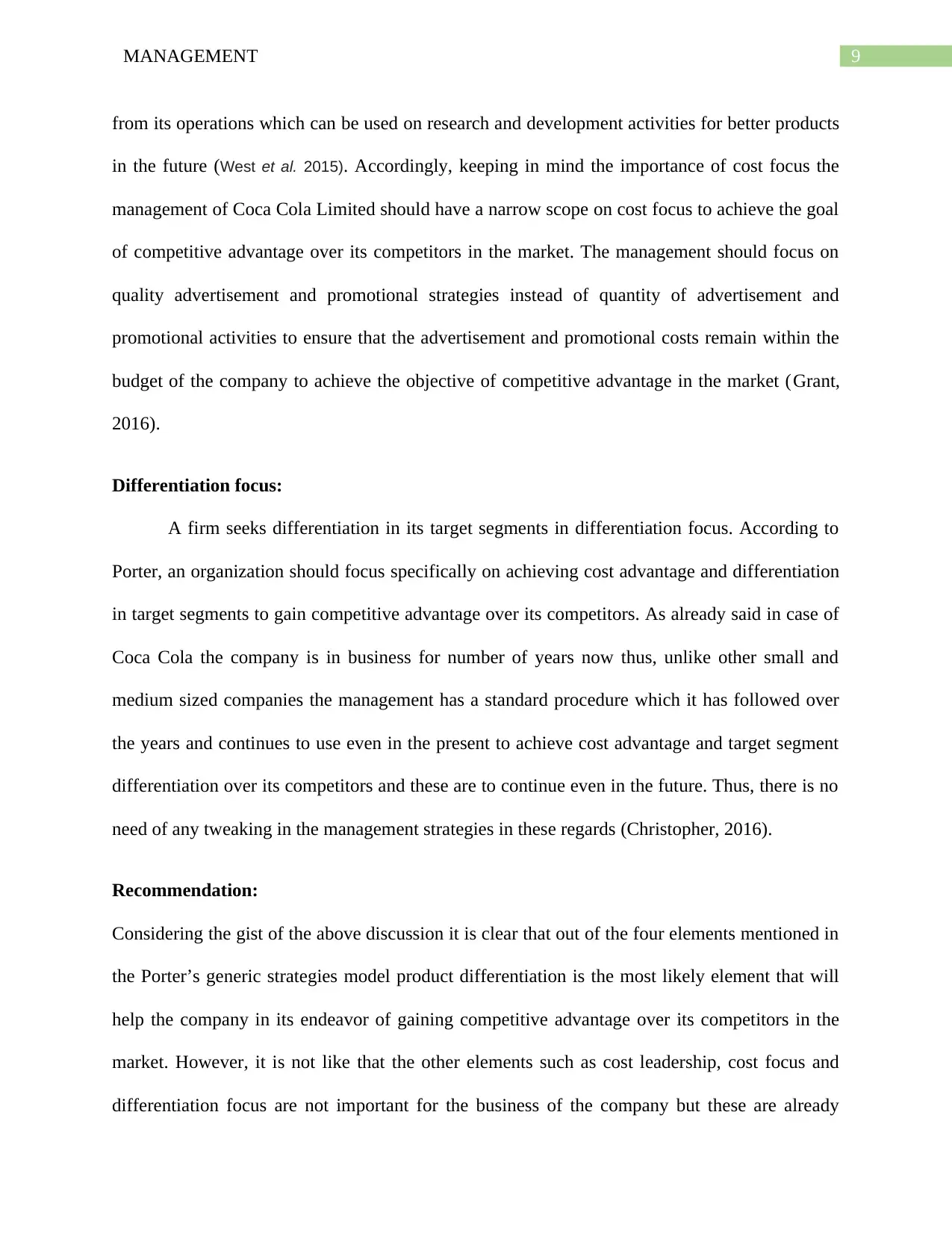
9MANAGEMENT
from its operations which can be used on research and development activities for better products
in the future (West et al. 2015). Accordingly, keeping in mind the importance of cost focus the
management of Coca Cola Limited should have a narrow scope on cost focus to achieve the goal
of competitive advantage over its competitors in the market. The management should focus on
quality advertisement and promotional strategies instead of quantity of advertisement and
promotional activities to ensure that the advertisement and promotional costs remain within the
budget of the company to achieve the objective of competitive advantage in the market (Grant,
2016).
Differentiation focus:
A firm seeks differentiation in its target segments in differentiation focus. According to
Porter, an organization should focus specifically on achieving cost advantage and differentiation
in target segments to gain competitive advantage over its competitors. As already said in case of
Coca Cola the company is in business for number of years now thus, unlike other small and
medium sized companies the management has a standard procedure which it has followed over
the years and continues to use even in the present to achieve cost advantage and target segment
differentiation over its competitors and these are to continue even in the future. Thus, there is no
need of any tweaking in the management strategies in these regards (Christopher, 2016).
Recommendation:
Considering the gist of the above discussion it is clear that out of the four elements mentioned in
the Porter’s generic strategies model product differentiation is the most likely element that will
help the company in its endeavor of gaining competitive advantage over its competitors in the
market. However, it is not like that the other elements such as cost leadership, cost focus and
differentiation focus are not important for the business of the company but these are already
from its operations which can be used on research and development activities for better products
in the future (West et al. 2015). Accordingly, keeping in mind the importance of cost focus the
management of Coca Cola Limited should have a narrow scope on cost focus to achieve the goal
of competitive advantage over its competitors in the market. The management should focus on
quality advertisement and promotional strategies instead of quantity of advertisement and
promotional activities to ensure that the advertisement and promotional costs remain within the
budget of the company to achieve the objective of competitive advantage in the market (Grant,
2016).
Differentiation focus:
A firm seeks differentiation in its target segments in differentiation focus. According to
Porter, an organization should focus specifically on achieving cost advantage and differentiation
in target segments to gain competitive advantage over its competitors. As already said in case of
Coca Cola the company is in business for number of years now thus, unlike other small and
medium sized companies the management has a standard procedure which it has followed over
the years and continues to use even in the present to achieve cost advantage and target segment
differentiation over its competitors and these are to continue even in the future. Thus, there is no
need of any tweaking in the management strategies in these regards (Christopher, 2016).
Recommendation:
Considering the gist of the above discussion it is clear that out of the four elements mentioned in
the Porter’s generic strategies model product differentiation is the most likely element that will
help the company in its endeavor of gaining competitive advantage over its competitors in the
market. However, it is not like that the other elements such as cost leadership, cost focus and
differentiation focus are not important for the business of the company but these are already
⊘ This is a preview!⊘
Do you want full access?
Subscribe today to unlock all pages.

Trusted by 1+ million students worldwide
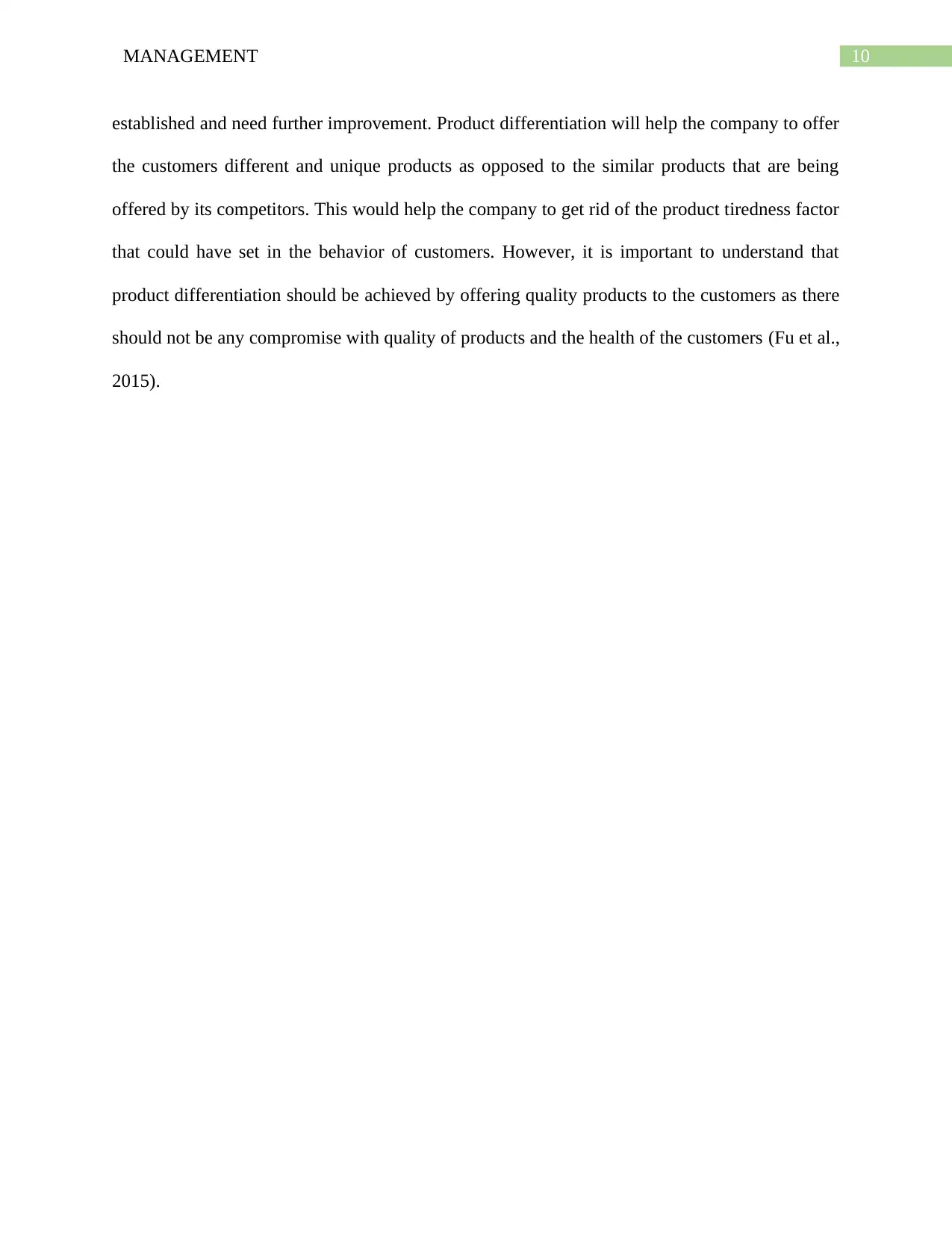
10MANAGEMENT
established and need further improvement. Product differentiation will help the company to offer
the customers different and unique products as opposed to the similar products that are being
offered by its competitors. This would help the company to get rid of the product tiredness factor
that could have set in the behavior of customers. However, it is important to understand that
product differentiation should be achieved by offering quality products to the customers as there
should not be any compromise with quality of products and the health of the customers (Fu et al.,
2015).
established and need further improvement. Product differentiation will help the company to offer
the customers different and unique products as opposed to the similar products that are being
offered by its competitors. This would help the company to get rid of the product tiredness factor
that could have set in the behavior of customers. However, it is important to understand that
product differentiation should be achieved by offering quality products to the customers as there
should not be any compromise with quality of products and the health of the customers (Fu et al.,
2015).
Paraphrase This Document
Need a fresh take? Get an instant paraphrase of this document with our AI Paraphraser
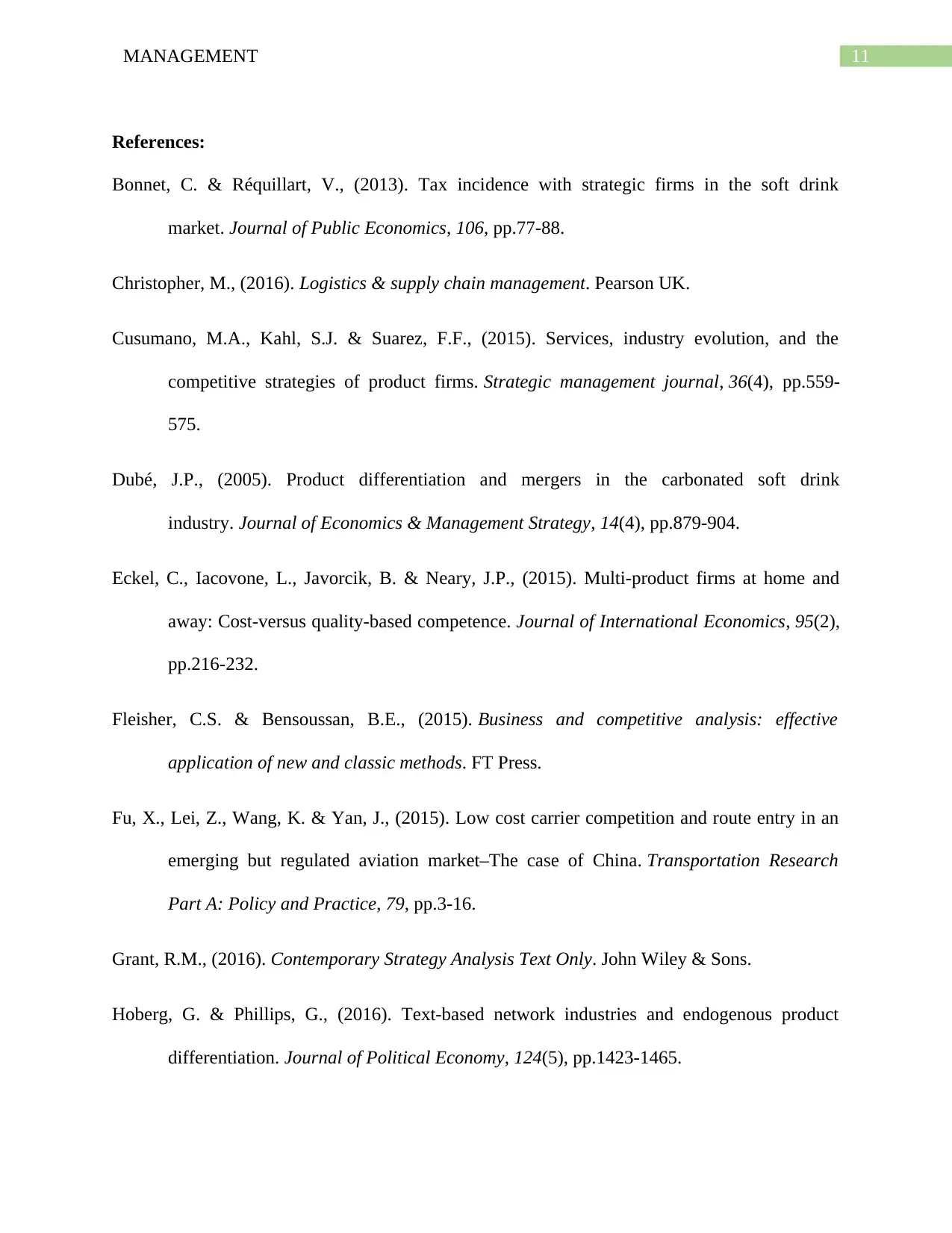
11MANAGEMENT
References:
Bonnet, C. & Réquillart, V., (2013). Tax incidence with strategic firms in the soft drink
market. Journal of Public Economics, 106, pp.77-88.
Christopher, M., (2016). Logistics & supply chain management. Pearson UK.
Cusumano, M.A., Kahl, S.J. & Suarez, F.F., (2015). Services, industry evolution, and the
competitive strategies of product firms. Strategic management journal, 36(4), pp.559-
575.
Dubé, J.P., (2005). Product differentiation and mergers in the carbonated soft drink
industry. Journal of Economics & Management Strategy, 14(4), pp.879-904.
Eckel, C., Iacovone, L., Javorcik, B. & Neary, J.P., (2015). Multi-product firms at home and
away: Cost-versus quality-based competence. Journal of International Economics, 95(2),
pp.216-232.
Fleisher, C.S. & Bensoussan, B.E., (2015). Business and competitive analysis: effective
application of new and classic methods. FT Press.
Fu, X., Lei, Z., Wang, K. & Yan, J., (2015). Low cost carrier competition and route entry in an
emerging but regulated aviation market–The case of China. Transportation Research
Part A: Policy and Practice, 79, pp.3-16.
Grant, R.M., (2016). Contemporary Strategy Analysis Text Only. John Wiley & Sons.
Hoberg, G. & Phillips, G., (2016). Text-based network industries and endogenous product
differentiation. Journal of Political Economy, 124(5), pp.1423-1465.
References:
Bonnet, C. & Réquillart, V., (2013). Tax incidence with strategic firms in the soft drink
market. Journal of Public Economics, 106, pp.77-88.
Christopher, M., (2016). Logistics & supply chain management. Pearson UK.
Cusumano, M.A., Kahl, S.J. & Suarez, F.F., (2015). Services, industry evolution, and the
competitive strategies of product firms. Strategic management journal, 36(4), pp.559-
575.
Dubé, J.P., (2005). Product differentiation and mergers in the carbonated soft drink
industry. Journal of Economics & Management Strategy, 14(4), pp.879-904.
Eckel, C., Iacovone, L., Javorcik, B. & Neary, J.P., (2015). Multi-product firms at home and
away: Cost-versus quality-based competence. Journal of International Economics, 95(2),
pp.216-232.
Fleisher, C.S. & Bensoussan, B.E., (2015). Business and competitive analysis: effective
application of new and classic methods. FT Press.
Fu, X., Lei, Z., Wang, K. & Yan, J., (2015). Low cost carrier competition and route entry in an
emerging but regulated aviation market–The case of China. Transportation Research
Part A: Policy and Practice, 79, pp.3-16.
Grant, R.M., (2016). Contemporary Strategy Analysis Text Only. John Wiley & Sons.
Hoberg, G. & Phillips, G., (2016). Text-based network industries and endogenous product
differentiation. Journal of Political Economy, 124(5), pp.1423-1465.
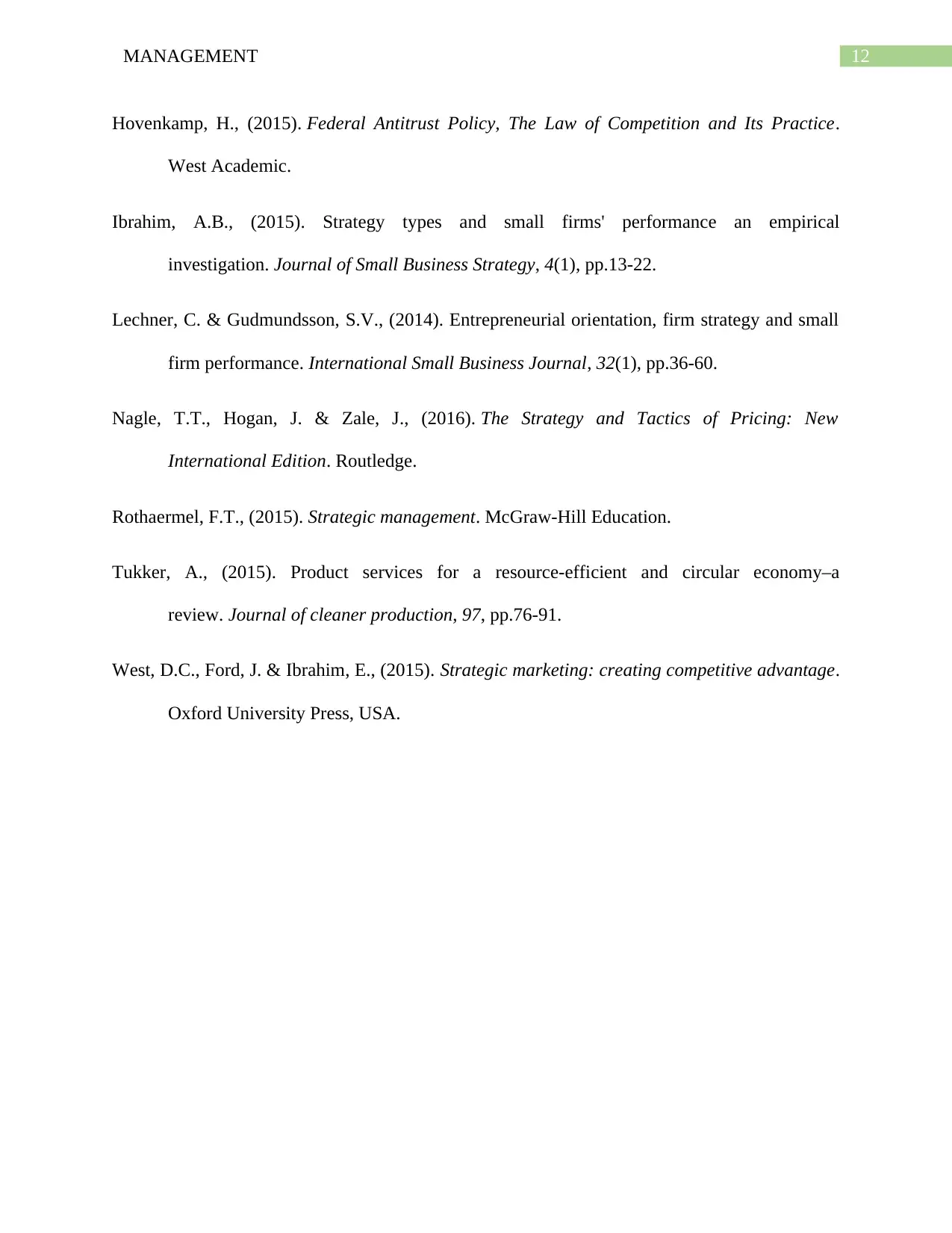
12MANAGEMENT
Hovenkamp, H., (2015). Federal Antitrust Policy, The Law of Competition and Its Practice.
West Academic.
Ibrahim, A.B., (2015). Strategy types and small firms' performance an empirical
investigation. Journal of Small Business Strategy, 4(1), pp.13-22.
Lechner, C. & Gudmundsson, S.V., (2014). Entrepreneurial orientation, firm strategy and small
firm performance. International Small Business Journal, 32(1), pp.36-60.
Nagle, T.T., Hogan, J. & Zale, J., (2016). The Strategy and Tactics of Pricing: New
International Edition. Routledge.
Rothaermel, F.T., (2015). Strategic management. McGraw-Hill Education.
Tukker, A., (2015). Product services for a resource-efficient and circular economy–a
review. Journal of cleaner production, 97, pp.76-91.
West, D.C., Ford, J. & Ibrahim, E., (2015). Strategic marketing: creating competitive advantage.
Oxford University Press, USA.
Hovenkamp, H., (2015). Federal Antitrust Policy, The Law of Competition and Its Practice.
West Academic.
Ibrahim, A.B., (2015). Strategy types and small firms' performance an empirical
investigation. Journal of Small Business Strategy, 4(1), pp.13-22.
Lechner, C. & Gudmundsson, S.V., (2014). Entrepreneurial orientation, firm strategy and small
firm performance. International Small Business Journal, 32(1), pp.36-60.
Nagle, T.T., Hogan, J. & Zale, J., (2016). The Strategy and Tactics of Pricing: New
International Edition. Routledge.
Rothaermel, F.T., (2015). Strategic management. McGraw-Hill Education.
Tukker, A., (2015). Product services for a resource-efficient and circular economy–a
review. Journal of cleaner production, 97, pp.76-91.
West, D.C., Ford, J. & Ibrahim, E., (2015). Strategic marketing: creating competitive advantage.
Oxford University Press, USA.
⊘ This is a preview!⊘
Do you want full access?
Subscribe today to unlock all pages.

Trusted by 1+ million students worldwide
1 out of 12
Related Documents
Your All-in-One AI-Powered Toolkit for Academic Success.
+13062052269
info@desklib.com
Available 24*7 on WhatsApp / Email
![[object Object]](/_next/static/media/star-bottom.7253800d.svg)
Unlock your academic potential
Copyright © 2020–2025 A2Z Services. All Rights Reserved. Developed and managed by ZUCOL.





